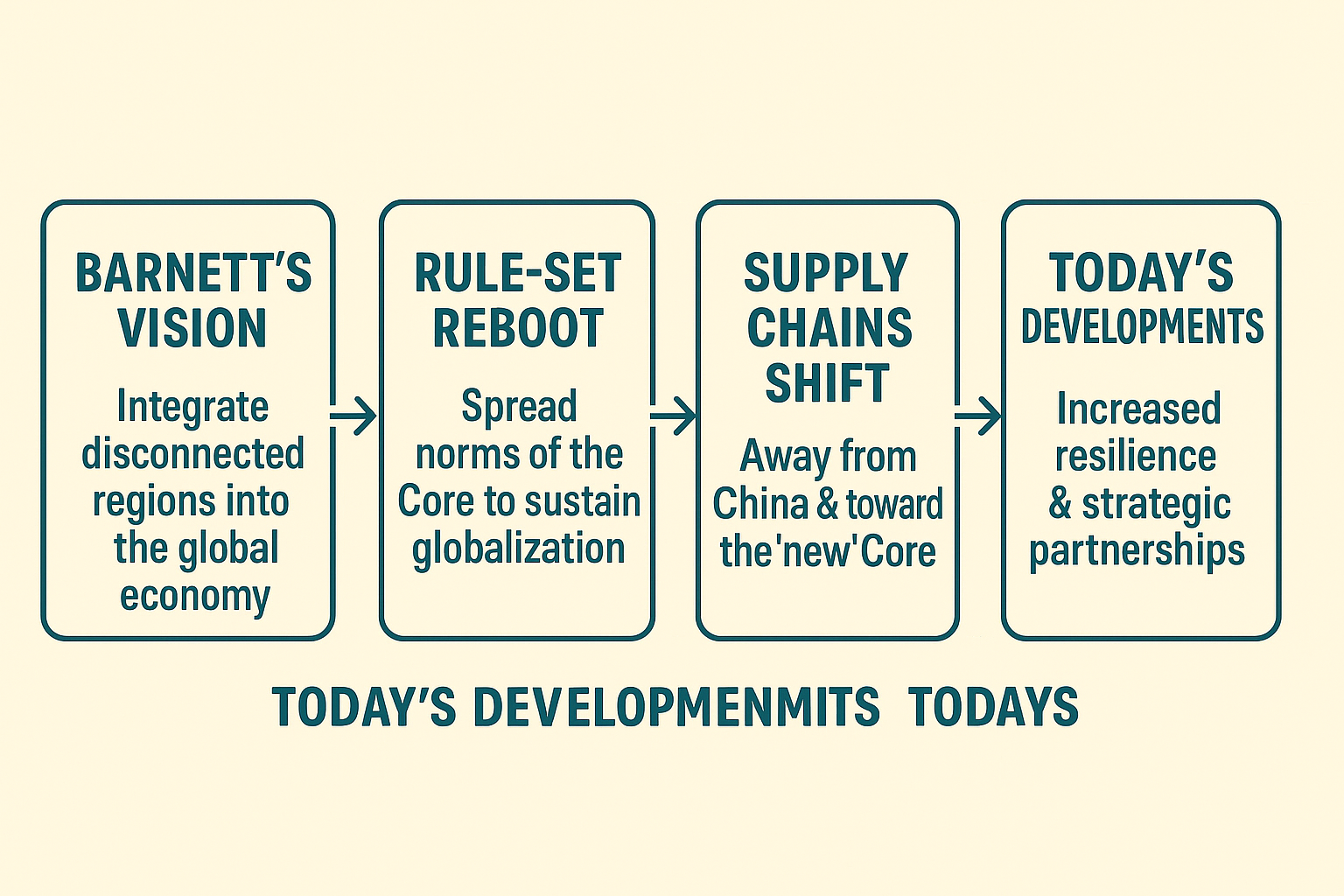Thomas Barnett, in his characteristically energetic and storytelling style, outlined a vision where resource distribution, climate change, demographic shifts, and economic globalization would reshape the world’s balance of power. His major insights, while sometimes delivered with humor, actually sketched an eerily accurate map of the realignment we are experiencing today.
1. Barnett’s Core Thesis: The Rise of the Global Food and Water Networks
Barnett described how food, more than energy, would become the dominant global network in the 21st century. His logic was simple but powerful:
- Energy grids would become more local (solar, smart grids).
- Food production, however, would become more global, because populations (especially in Asia and Africa) would outpace their own food production capacities due to climate, water shortages, and land limitations.
Key Point: Food and water would drive future alliances and conflicts more than oil.
He outlined how countries rich in water (Canada, U.S., New Zealand, parts of South America) would become agricultural giants feeding an increasingly urbanized, hungry, and dependent world.
Today, we see this happening:
- China is buying agricultural land around the world (Africa, South America, even the U.S.).
- Middle Eastern nations are investing in global farming, knowing their desert climates cannot support the needed food.
- Water scarcity is becoming a serious geopolitical issue (e.g., the Nile disputes between Egypt and Ethiopia; water rights in South Asia).
- Food price shocks (like during the 2010-2011 Arab Spring) have had political consequences.
2. Climate Change and the “New North”
Barnett predicted that climate migration northward would define the future:
- Northern regions (Canada, Russia, Scandinavia) would become agricultural and economic powerhouses.
- Droughts, heatwaves, and desertification would cripple much of the equatorial “Gap” countries (Africa, Middle East, parts of Asia and Latin America).
Today, data confirms this:
- Russia is now one of the largest exporters of wheat.
- Canada’s arable land is increasing as permafrost retreats.
- The Arctic Council has become a serious geopolitical forum (resource rights, shipping routes).
- Mass migrations (from Africa to Europe, from Central America to the U.S.) have intensified because of environmental devastation.
Barnett saw the “New North” as stable, rich, and democratic — controlling the future of agriculture, fresh water, and energy.
3. The Western Hemisphere: Latinization and the Future of America
Another critical insight was the Latinization of America:
- Hispanic Americans, Barnett noted, would transform the U.S. demographically, culturally, and economically.
- He warned that the U.S. could either integrate these populations successfully (adding new “stars” to the national fabric) or risk internal division, rebellion, and demographic chaos.
Today, this trend is accelerating:
- Latinos are now the largest minority group in the U.S. (18-19% and growing).
- Political power is shifting with it (Texas, Arizona, Nevada, and Florida elections increasingly influenced by Hispanic voters).
- Cultural blending is reshaping America, but tensions remain (immigration debates, border policies).
Barnett’s deeper point: If America embraces its Latin American neighbors (Mexico, Central America), it stays strong. If it walls them out and fails to integrate, it weakens.
4. The Role of the Oligarchy: Commerce, Control, and Distraction
Barnett touches implicitly on a deeper pattern — the global elite’s management of the “core” and “gap” populations.
This ties directly into:
- Noam Chomsky’s observation that populations are controlled through consumption and distraction.
- Historical patterns (Rome, Britain, U.S.) showing that elites maintain dominance through cheap bread, spectacles, entertainment, and debt.
Today, we see:
- Tech giants (Amazon, Facebook, Google) dominate information and consumption.
- Financial elites concentrate global wealth at unprecedented levels.
- Publics are distracted with endless media, identity politics, celebrity culture — while structural economic and geopolitical shifts go largely unnoticed.
- The “global oligarchy” moves its bases of power from Britain → U.S. → now increasingly hedging with China.
5. The Rise of China and the Shifting Core-Gap Dynamics
China, which Barnett foresaw would need massive imports of food, water, and energy, has executed strategic plans:
- Belt and Road Initiative: Building infrastructure across Asia, Africa, and Europe.
- Buying land abroad: Acquiring farmland in Africa, Australia, and Latin America.
- Securing water: Engineering major river systems and damming Tibetan water sources.
- Building military: Especially a Navy that can protect maritime trade routes (especially vital for food and energy imports).
Meanwhile, the U.S., distracted by internal culture wars and oligarchic plundering, risks ceding leadership.
6. The Emerging Global Structure: Fragmented Multipolarity
Barnett’s world has become reality:
- A multipolar world: U.S., China, Russia, EU, India all jockey for influence.
- Food, water, and climate drive alliances more than ideology.
- Mass migration pressures from south to north destabilize political systems.
- Digital and physical walls are rising — data firewalls, immigration controls, nationalism — while economic interdependence grows.
In short: The world is messy, interconnected, and unstable.
Conclusion: Where We Are Today
Barnett’s vision is largely accurate — and even prophetic:
- Food and water networks are central geopolitical tools.
- Climate change is remapping power.
- Latin America is increasingly crucial to the U.S.’s future.
- The Global Elite (commerce-driven, borderless) continues consolidating power while populations fight among themselves.
- China is rising rapidly but faces internal limits (aging population, water shortages).
The key takeaway for individuals and nations is simple:
- Adapt.
- Build real alliances (not just military).
- Focus on sustainability (especially food, water, and infrastructure).
- Empower decentralized local systems while maintaining global trade and cooperation.
- Resist distraction and remain strategically aware of the deeper shifts underneath the media noise.
In the coming decades, those societies and individuals who understand these trends will not only survive but thrive.







